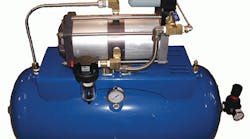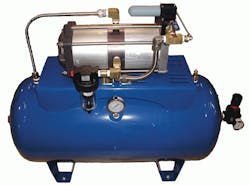With its dumpy fat cylindrical shape, dull-painted exterior, lack of visible dynamic activity, and frequently hidden location, it’s easy to understand why the air receiver usually is the orphan of the plant-air system family. There is confusion and controversy over its function, where it should be located, what size it should be, how it should be piped — and whether it is needed at all. Air receivers are one of the least understood, yet potentially most useful components available to increase operating efficiency. But an air receiver should be an integral part of any plant air system — mainly to enhance its efficiency. Here are the classic purposes:
Contaminant removal — A bare receiver (without a pressure regulator or flow controller) adds a large volume to the piping system. This volume reduces air-flow velocity and encourages finely divided particles of liquid lubricant or condensate to drop out of the air stream. These separated liquids can then be drained from the receiver, rather than traveling with the compressed air or gas to create adverse downstream effects.
Pulsation dampening— A receiver installed near the compressor discharge dampens pressure pulses from positive-displacement compressors (rotary or reciprocating) to a small fraction of their original amplitude. This reduces the probability of excess compressor power or shortened service life resulting from resonant response to the frequency of compressor delivery.
Pressure stabilization— A receiver combined with a pressure regulator or flow controller can create an effective pressure band or differential between the supply side and the demand side. A typical example: 95 psig in the receiver, 90 psig steady to the system. This allows the demand side to operate at its lowest effective pressure, and therefore lowest volume demand. Stored air with a pressure differential creates volume held in reserve to cover short-term peak demands that exceed current air supply — without turning on or loading another compressor.
A one-atmosphere pressure change (less than 15 psi) accommodates a free air volume equal to that of the receiver. This can be used in the primary receiver, in a secondary receiver on the demand side (to serve an operation with surge demand), or even as off-line peak-shaving storage.
Augment compressor controls— Receivers with appropriate volume can reduce and decelerate pressure changes caused by intermittent use of compressed air. Compressor controls, which normally respond to pressure, can smoothly regulate compressor output without frequent ranging through their full control span. If an operation has capacity controls, but only a short run of pipe, a receiver will provide the total storage volume needed for the control to perform effectively.
Other effective ways to manage a stable pressure exist, depending on system dynamics. A networking control system can manage the compressed-air supply to hold a set target pressure at the system entry. Also, a variable-speed drive trim compressor can hold a pressure differential as low as 1 psig throughout its full operating range, eliminating the control band rise.
Controlling energy costs
industry management began to focus on energy-cost control to reduce production costs, energy managers soon realized that compressed air was their most expensive utility. After all, it takes 8 hp of electricity to produce 1 hp of compressed air. Air no longer was perceived as free. Its cost should,
and could, be managed.
Early efforts in compressed-air cost management focused on the obvious — controlling leaks and lowering usage. But after a significant reduction in air usage, an energy audit often revealed little or no reduction in actual electric power consumed. This disappointing result usually came because of the absence of an air receiver, combined with poor or too small interconnecting piping from the compressor to the system entry.
Insufficient effective storage did not allow the compressor capacity controls to translate lower air demand into lower input energy. Without effective storage, most unloading controls could not establish and hold enough idle time as a percent of running time. Nor could they optimize the automatic start/stop control and shut off.
The normal operating band for a compressed air supply is 10 psig. Effective storage capacity is created at the location where this band is neutralized (ie., a 10-psig operating-pressure band is neutralized at the point where 10 psid is needed to get air through the interconnecting piping, dryer, filters, etc. and into the demand system).
A little history
Almost all plant-air systems used to have a compressor that was piped to an air receiver. With the advent of rotary-screw, vane, and centrifugal compressors during the late 1960s and 1970s, this arrangement changed. Two compelling features of early sales presentations for rotary units were:
• They produce no damaging pulsations in the discharge air.
• With a rotary compressor, you did not need an air receiver — as long as your piping provided a minimum storage volume of “at least one gallon per cfm of air compressor capacity.”
Early rotary and centrifugal models, when fitted with modulating and blow-off unloading controls respectively, lived up to those expectations. Refinement of rotary and centrifugal compressor unloading controls during the early to mid 1980s strove to minimize the lower-load inefficiencies of earlier arrangements. Although these controls sometimes worked well enough with large-diameter piping systems, the storage myth began to crumble. Installations that relied on pipe volumes for air storage found the power savings of their new controls non-existent or much less than originally promised.
Contributing problems
Many plant air system reviews reveal situations that keep the supply side from running in an optimum mode to meet demand:
• High pressure loss between the compressor discharge and the air receiver or system that causes the loss of the operating band before getting to the air receiver/distribution-piping. Pressure loss can be caused by poorly selected dryers and filters, interconnecting piping that is too small, and a high-velocity piping configuration with dead heads, crossing tees, and other generators of excess back-pressure.
• Existing large (5000 to 20,000 gal) air receivers flow controllers, but have inadequate effective storage between them and the air supply. They stabilize pressure (if not bypassed in frustration), but don’t allow optimum operation of supply-capacity control.
Exceptions to this scenario exist, but in general, this condition became more of a problem. Sophisticated electronic controls not only allowed more finite control of unloading but also showed how the lack of an air receiver contributed to the energy problem.
Pressure loss is the culprit
In systems installed during the 80s and 90s, we find excessive pressure losses in interconnecting piping, dryers, and filters in 85% to 90% of the installation. Over the last 15 plants-air systems we audited, we found four with large tanks and pressure/flow controllers installed. These had been bypassed in three of the plants to try to recover pressure. (Remember, a regulator can be a choke.) The fourth plant was using the pressure /flow controller but only delivered 2000 to 2100 of its available 3000 cfm to the demandside at minimum required pressure of 90 psig.
The culprit in these situations was too high a pressure loss (18 to 25 psig) at full load due to small, poorly installed piping. In two plants, piping loss was exacerbated by the normal pressure losses of 4 to 5 psid in the dryer and 3 to 5 psid in the filters. (Effective filters are available with l psid or less and 5-year design life to reduce such high pressure losses. Dryers can be oversized, within appropriate guidelines.)
Forward-thinking manufacturers made these costly mistakes while trying to address compressed-air energy issues. (A knowledgeable air-system consultant might have avoided the mistakes.) There is no panacea for air systems, but air receivers installed and operated correctly (using appropriate data) can be an excellent system-enhancement tool.
Today, most compressed-air-system consultants, compressor manufacturers, and design engineers have put aside the myth of using piping for storage. They recommend a bona fide compressed-air receiver on every installation — with sufficient capacity to create effective idle time.
This information was provided by Hank van Ormer, president, Air Power USA, Baltimore, Ohio. For more information, visit www.airpowerusainc.com.


